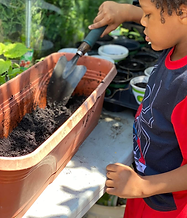
If You Want to Know What You Are Eating...Grow It!
In a world of instant everything, growing your own food is a quiet rebellion - and a powerful one. It's a way to break generational cycles of dependence on unhealthy, processed, or inaccessible food and move back toward self-sustaining, life giving practices.
Working in the soil is healing. It connects you to earth and your ancestors. There is something sacred about growing collards or Sweet Potatoes in your own backyard, knowing your grandmother did the same thing.
Whether you're harvesting basil from a windowsill or pulling carrots from a grow bag, homegrown food often tastes better, costs less in the long run, and brings a sense of pride that a grocery store can't offer. It's also a fun, hands-on way to teach children (and ourselves) about nature, nutrition, and the journey of a tiny seed becoming a staple on the dinner table.

For us, it all started one sunny afternoon when my children and I decided to plant a few Bell Pepper seeds in some foam cups in our backyard. We had no grand plan - just a packet of seeds, a bit of soil, and a lot of curiosity. What began as a simple Homeschool Project quickly turned into one of our favorite family activities. The excitement on their faces when the first tree sprouts peeked through the soil was priceless. Over time we added leafy greens, other kinds of peppers, strawberries and even an Apple Tree!
Watching our little garden grow not only brings fresh food to our table but has also sparked conversations about nature, responsibility, and healthy eating. The experience has taught me that growing your own food doesn't require a huge backyard or expert knowledge - it just takes a bit of space, some patience, and a willingness to get your hands dirty. In this section I'll share what we've learned, how to get started, and why it's one of the most rewarding things you can do for your home and family.



